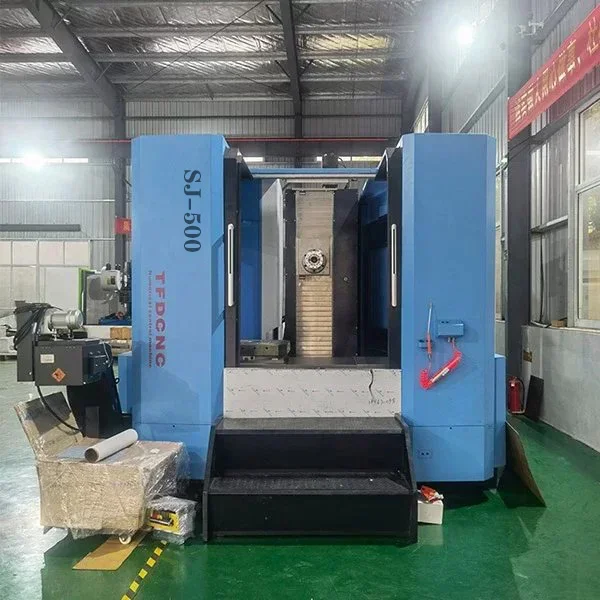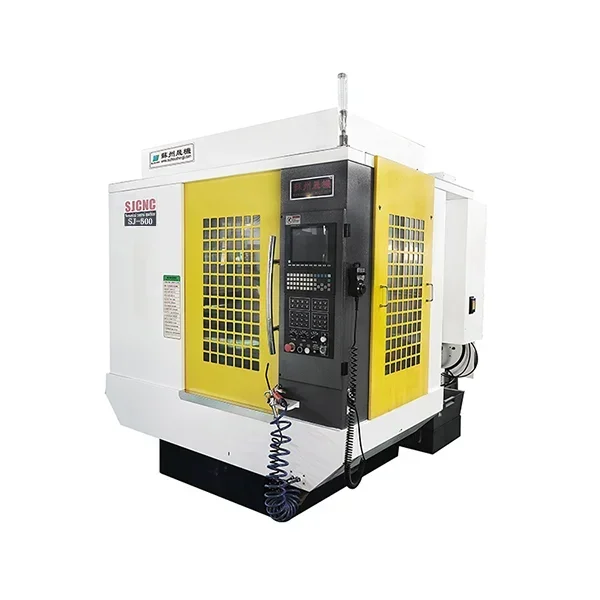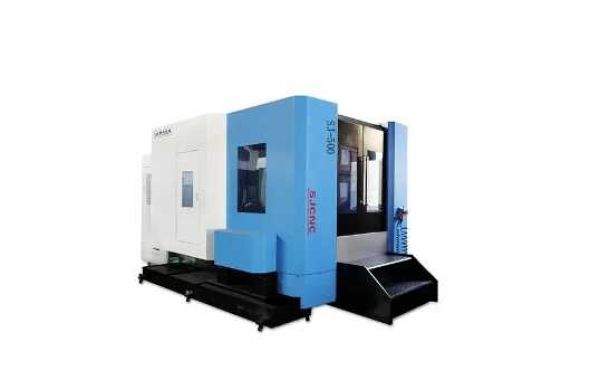Are you ready to dive into the exciting world of machining centers? These versatile machines are the backbone of modern manufacturing, allowing precise and efficient fabrication of a wide range of products. In this blog post, we will explore the key differences between horizontal and vertical machining centers, uncovering their unique features, benefits, and applications. Whether you're a seasoned expert or new to the industry, get ready for an informative journey that will leave you with a clearer understanding of these powerful tools.
Comparison between horizontal and vertical machining centers
When it comes to machining centers, two popular options are horizontal and vertical machining centers. Both types offer unique features and benefits that cater to different manufacturing needs.
One key difference between the two is their orientation. As the name suggests, a horizontal machining center has its spindle positioned horizontally, while a vertical machining center has its spindle oriented vertically.
The orientation of the spindle plays a significant role in determining the type of work each machine can handle efficiently. Horizontal machining centers excel at tackling larger and heavier workpieces due to their robust design and ability to support multiple axes. They provide excellent stability during heavy cutting operations, making them ideal for industries like aerospace or automotive where precision and reliability are crucial.
On the other hand, vertical machining centers are known for their versatility and flexibility. With their compact footprint, these machines are suitable for smaller workshops or jobs that require frequent tool changes. Vertical machines have an advantage when it comes to drilling holes or performing tasks that involve plunging into materials vertically.
Understanding the differences between horizontal and vertical machining centers allows manufacturers to choose the right machine based on specific requirements such as workpiece size, material type, complexity of operations, budget constraints, etc. Each type offers distinct advantages that make them valuable assets in various industries.

Key features and benefits of a horizontal machining center
A horizontal machining center (HMC) is a versatile piece of equipment that offers numerous advantages in the world of manufacturing. One key feature of an HMC is its horizontal spindle orientation, which allows for efficient chip evacuation during the machining process. This means less downtime and increased productivity.
Another notable feature of an HMC is its multi-axis capability. With multiple axes, it can perform complex machining operations with precision and accuracy. This makes it ideal for applications that require intricate shapes or tight tolerances.
The rigidity of a horizontal machining center also sets it apart from other machines. Its sturdy construction ensures minimal vibration, resulting in superior surface finishes on machined parts. Additionally, the design allows for better accessibility to workpieces, making setup and tool changes easier.
In terms of benefits, one major advantage is the ability to machine multiple sides of a part without repositioning it. This significantly reduces cycle time and eliminates errors associated with repositioning.
Furthermore, HMCs offer high production capacity due to their automatic tool changers and large tool magazines. This enables uninterrupted operation as tools are automatically selected based on programmed instructions.
When compared to vertical machining centers (VMCs), HMCs excel at heavy-duty cutting tasks because they can handle larger workpieces and heavier loads with ease.
The key features and benefits make horizontal machining centers invaluable assets in various industries such as aerospace, automotive manufacturing, mold-making, and more!
Applications of a horizontal machining center
A horizontal machining center (HMC) is a versatile and powerful machine tool that offers numerous applications across various industries. Its unique design allows for precision machining in different orientations, providing efficient solutions for complex tasks.
One of the key applications of an HMC is in aerospace manufacturing. With its ability to handle large and heavy workpieces, it can efficiently mill and drill components such as aircraft wings or engine parts. The HMC's horizontal spindle orientation allows for better chip evacuation, reducing the risk of damage to delicate components.
In the automotive industry, HMCs are used for producing engine blocks, transmission cases, and other critical components with high accuracy and repeatability. The horizontal spindle configuration enables simultaneous multi-axis machining, increasing productivity while maintaining tight tolerances.
The energy sector also benefits from the capabilities of an HMC. It can effectively machine turbine blades, generator housings, and oil drilling equipment with intricate geometries. Moreover, its robust construction ensures stability during heavy-duty operations.
Other applications include mold making in the plastics industry where HMCs excel at producing precise molds with intricate details. Additionally, they are utilized in general machining tasks like milling slots or pockets on large workpieces.
The wide range of applications offered by a horizontal machining center makes it an indispensable tool across industries requiring high-precision machining capabilities combined with efficiency and reliability.

Key features and benefits of a vertical machining center
A vertical machining center (VMC) is a versatile tool that offers numerous advantages in the manufacturing industry. Here, we will explore some key features and benefits of using a VMC.
One of the standout features of a VMC is its vertical spindle orientation. This allows for easy access to the workpiece from above, making it ideal for tasks such as drilling holes or creating slots. The vertical configuration also enables efficient chip evacuation, reducing the risk of chip buildup and prolonging tool life.
Another benefit of using a VMC is its ability to perform multi-axis machining operations. With advanced CNC controls, these machines can effortlessly execute complex movements along multiple axes simultaneously. This capability opens up endless possibilities for intricate part production and increases productivity.
Furthermore, VMCs often have automatic tool changers integrated into their design. This feature enables seamless transitions between different tools without manual intervention, saving valuable time during production runs.
Additionally, many modern VMCs are equipped with high-speed spindles capable of achieving rapid feed rates and precise cutting speeds. This results in shorter cycle times and improved surface finishes on machined parts.
Moreover, VMCs offer excellent accuracy and repeatability due to their rigid construction and precise positioning systems. These machines are designed to maintain consistent performance over long periods while ensuring tight tolerances are consistently achieved.
In conclusion,the vertical machining center has become an indispensable asset in various industries due to its versatility and efficiency.
With its unique features like vertical spindle orientation,multi-axis capabilities,automatic tool changers,high-speed spindles,and exceptional accuracy;it's no wonder why manufacturers rely on this technology for their machining needs.Whether you need to create prototypes or produce large quantities with precision,a vertical machining center is undoubtedly worth considering for your next project.
Applications of a vertical machining center
A vertical machining center (VMC) is an essential tool in the manufacturing industry, offering a wide range of applications. One key application is milling, where the VMC can efficiently cut and shape various materials such as metal, wood, or plastic. With its precision and versatility, it becomes an ideal choice for creating intricate parts or components.
Another important application is drilling. The VMC's ability to accurately drill holes at different angles and depths makes it invaluable in industries like aerospace or automotive where precision is crucial. Whether it's creating holes for fasteners or tapping threads, the VMC delivers consistent results with speed and efficiency.
Additionally, the VMC excels in contouring operations. It can effortlessly create complex shapes by following programmed paths using advanced software systems. This enables manufacturers to produce intricately designed products that meet precise specifications.
Furthermore, the vertical machining center finds extensive use in prototyping and small-batch production. Its flexibility allows for quick setup changes between jobs, reducing downtime and increasing productivity. From rapid prototyping to producing customized parts on demand, the VMC offers immense value to businesses seeking agile manufacturing solutions.
Moreover, with advancements in technology like 5-axis capabilities, a vertical machining center opens up even more possibilities for multi-sided machining tasks. This means manufacturers can tackle complex projects that require cutting from multiple angles without needing additional setups or equipment.
In conclusion,the applications of a vertical machining center are vast and varied – from milling to drilling to contouring – making it an indispensable tool in modern manufacturing processes. Its precision, versatility, and efficiency enable businesses across industries to create high-quality products while maximizing productivity.

Conclusion
As we explore in this article, both horizontal machining centers (HMCs) and vertical machining centers (VMCs) have unique features and benefits.
HMC is known for its exceptional stability and rigidity, making it ideal for heavy-duty cutting operations. With its horizontally oriented spindle, the HMC offers excellent chip evacuation and can easily handle large workpieces. They offer high precision and accuracy and are suitable for use in industries such as aerospace, automotive, oil and gas.
VMCs, on the other hand, are versatile machines that excel in applications that require complex cuts or multiple setups. Its vertical spindle allows easy access to the workpiece from different angles. VMC is typically used on smaller workpieces or complex parts that require precise detail.
Both HMC and VMC are equipped with advanced technologies such as CNC control systems, tool changers, coolant systems and automatic pallet changers. These features increase the productivity and efficiency of machining operations.
Overall, we hope this article gave you a comprehensive understanding of the differences between horizontal and vertical machining centers. Both types have unique advantages and find applications in different industries. Whether you need heavy-duty cutting capabilities or versatile precision machining, there's a machine for you. So what are you waiting for? Come to Shengji website to select the processing products you need.
Suzhou Shengji Intelligent Equipment Co., Ltd. is a CNC machine tool processing base established by Taiwan Tai Fuda in Suzhou based on the Chinese market (Tai Fuda is a brand sold by Taiwan to Europe, and has more than 30 years of technical research on CNC and CNC intelligent machine tools. RD experience).Welcome to inquiry if you need to know more about horizontal machining centers details or order wholesale.
Email:sunny@shengjicnc.com







